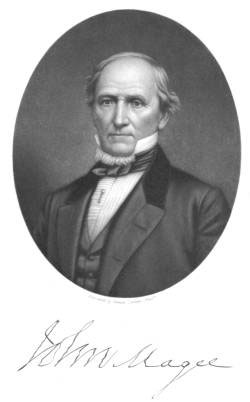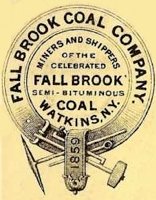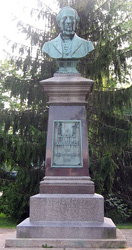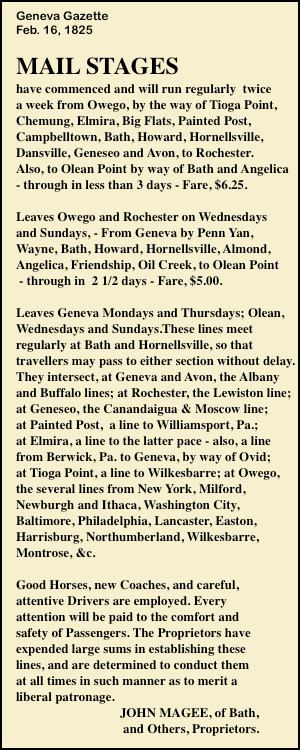
John Magee
 Born near
Easton, Pennsylvania, John Magee (b. 1794, d. 1868) was considered a hero in the War of 1812; he
carried messages on horseback from Gen. Hull at Detroit to Washington, and escaped under gunfire twice. He took up
residence in Bath, Steuben County, NY, in 1816. His paternal ancestors came from County Antrim, Ireland, in 1756,
and settled near Easton. His mother's people came from Ayrshire, Scotland, and his mother from the north of England,
settling in Loudoun county.
Born near
Easton, Pennsylvania, John Magee (b. 1794, d. 1868) was considered a hero in the War of 1812; he
carried messages on horseback from Gen. Hull at Detroit to Washington, and escaped under gunfire twice. He took up
residence in Bath, Steuben County, NY, in 1816. His paternal ancestors came from County Antrim, Ireland, in 1756,
and settled near Easton. His mother's people came from Ayrshire, Scotland, and his mother from the north of England,
settling in Loudoun county.
John Magee owned large tracts of timber land in Michigan and Wisconsin, and was involved in land speculation, lumbering, milling, as well as stage coach and banking interests. Between 1818 and 1826, he served as constable and collector of Bath, NY, and deputy sheriff, high sheriff, and census marshal for Steuben County. Around the same time, along with other partners, he established stage coach lines and transported U.S. mail under contract in New York State, later expanding to Pennsylvania and Washington. ("The first stage passed through Tyrone, New York, in the year 1821, owned by John Magee of Bath.") Active in Democratic politics, he became a Congressman in 1826, turning operation of the stage lines over to his brother, Thomas Jefferson Magee. He served two terms in the House of Representatives, during which he was an advisor to President Andrew Jackson. He directed the affairs of the newly organized Steuben County Bank from 1831 until his death.
In 1831, he was one of the first incorporators of the Bath and Crooked Lake Railroad Company which, when built in 1835, became the Bath & Hammondsport Railroad. In 1832, he was one of the 75 incorporators of the the New York and Erie Railroad, to connect the Hudson River, at Piermont, NY, to Lake Erie, at Dunkirk. Although ground was broken in 1835 in Piermont, it was not until 1848 that construction had proceeded west to Binghamton. In the late 1840s, Cook & Company, consisting of John Magee, Constant Cook, John Arnott, Charles Cook and John Cheddell, got the contract to construct the Erie roadway between Binghamton and Hornellsville. By 1849, the road had been extended from Binghamton, thru Owego and Elmira, to Corning. It finally reached Dunkirk, on Lake Erie, in 1851. In 1850, the Buffalo and Conhocton Valley Railroad was incorporated, with John Magee as President. By October, 1851, forty-five miles of the road was completed from Painted Post, near Corning, to the northern edge of Steuben County. After financial difficulties, it was taken over by the Erie.
In 1854 John Magee obtained ownership of the Corning and Blossburg Railroad in receivership, changing the operating name a few months later to the Blossburg and Corning Railroad. This road began as the Tioga Coal, Iron, Mining and Manufacturing Company, incorporated in New York in 1828 to construct a canal to bring coal from the Pennsylvania line to a junction of the Tioga and Chemung rivers near Corning, New York, where it could be loaded on barges. In 1833 it was authorized to build a railroad from the termination of the Chemung canal feeder to the Pennsylvania line, and was renamed the Corning and Blossburg Railroad in 1851.*
 In 1851 Magee obtained the lease for the coal mines at Blossburg, Pennsylvania, held earlier
by Mallory & Bostwick of Corning, New York. Tiring of working under a lease, his son, Duncan S. Magee, began
searching for new coal lands in 1856, resulting in the discovery of coal near Fall Brook, Tioga County,
Pennsylvania, and the organization of the Fall Brook Coal Company in 1859. He created the mining
town of Fall Brook, PA. In 1864, as business increased, John relocated from Bath to Watkins, NY. He purchased
extensive acreage (for trestle works, coal shipment & delivery, homes for his employees, as well as his own
home). He eagerly contributed to the erection of county buildings, cemetery grounds, and new streets and highways.
He donated $30,000 to help erect The First Presbyterian Church and parsonage in the Village of Watkins and, when building
costs soared beyond that, he committed additional funds as well. Ironically, the first service in this new church
was John Magee's 1868 funeral. (The First Presbyterian Church is active
to this day, and recently recognized John Magee on the 150th
anniversary of his death.) The discovery of coal near Wilson's Creek in 1866 led to the construction of the
Wellsboro and Lawrenceville Railroad, which was completed to the mines at Antrim in 1872, after his
death. * In 1867 he was selected to be a delegate to the Constitutional Convention of the State of New York -- his
last public service as his health was rapidly declining.
In 1851 Magee obtained the lease for the coal mines at Blossburg, Pennsylvania, held earlier
by Mallory & Bostwick of Corning, New York. Tiring of working under a lease, his son, Duncan S. Magee, began
searching for new coal lands in 1856, resulting in the discovery of coal near Fall Brook, Tioga County,
Pennsylvania, and the organization of the Fall Brook Coal Company in 1859. He created the mining
town of Fall Brook, PA. In 1864, as business increased, John relocated from Bath to Watkins, NY. He purchased
extensive acreage (for trestle works, coal shipment & delivery, homes for his employees, as well as his own
home). He eagerly contributed to the erection of county buildings, cemetery grounds, and new streets and highways.
He donated $30,000 to help erect The First Presbyterian Church and parsonage in the Village of Watkins and, when building
costs soared beyond that, he committed additional funds as well. Ironically, the first service in this new church
was John Magee's 1868 funeral. (The First Presbyterian Church is active
to this day, and recently recognized John Magee on the 150th
anniversary of his death.) The discovery of coal near Wilson's Creek in 1866 led to the construction of the
Wellsboro and Lawrenceville Railroad, which was completed to the mines at Antrim in 1872, after his
death. * In 1867 he was selected to be a delegate to the Constitutional Convention of the State of New York -- his
last public service as his health was rapidly declining.
John Magee died April 5, 1868 and was succeeded by his son, Duncan S. Magee. (Duncan passed on thirteen months later. John's other son, Gen. George J. Magee, took over the Magee interests until his death in 1897, when George's son, Col. John Magee, took charge.)
In addition to the Fall Brook interests, at his death, John Magee also had major investments in the Corning and Seneca Lake Railroad Company; Green Bay and Mississippi Improvement Company; Blossburg and Erie Junction Rail Road Company; major land investments in Wisconsin; Steuben County Bank; Buffalo, New York & Erie Railroad Company; Union Trust Company; Bath Gas and Light Co.; Mt. Carbon Coal and Railroad Company; as well as numerous municipal bonds, mortgages and notes.
 |
| John Magee Monument Wellsboro, PA. |
A monument to John Magee was unveiled on December 1, 1886 at Wellsboro, PA. A very lengthy address was delivered by Hon, Daniel Beach. Outdoors, to a large crowd, in the dead of winter. Hardy Folk. "For the building of the railroad to Wellsboro I need not remind you that you are indebted to the foresight of John Magee. It was conceived, planned and provided for by him and left to be accomplished under the lead and direction of his son, now with us today on this occasion."
In a paper read before the Tioga County Historical Society at Wellsboro, Pa., April 15th, 1909, by Anton Hardt, of Wellsboro, Pa., Mr. Hardt describes John Magee:
"I met Hon. John Magee for the first time on Oct. 17, 1867, at Lyman Smith Hotel, in Tioga. He was then seventy-three years old, but still a fine looking man, about six feet tall, stralght and well-built, with smooth face and piercing eyes; he could not help Impressing anyone as a man of superior faculties. He was dressed In black broadcloth and carried a gold headed cane. I noticed that his shirt bosom was ruffled and snow white, and when I called at his home in Watklns, N. Y., later on, his ruffled shirt attracted my attention again. Evidently his good wife took special pains with It, as at that time there was no laundry.
In Watklns. I was told that Mr. Magee at one time wanted to negotiate a loan with a banker In Philadelphia, who was a Quaker, and was refused. Upon inquiry, Mr. Magee learned that the Quaker objected to loan money to a man who went around with a frilled shirt. As I had special charge of the design of the Magee monument, on the public square In Wellsboro, I Insisted that the sculptor, Mr. Conkey, should represent the frilled shirt bosom on the bust."(The History of The Railroads of Tioga County - Anton Hardt, 1908)
(* compiled or directly quoted from public records in the Pennsylvania State Archives)
 John Magee Obituary
John Magee ObituaryCorning Journal
April 9, 1868
On Sunday forenoon, Hon. John Magee died at his residence in Watkins, aged 74 years. He had an attack of paralysis nearly two weeks previous. His death is a sad event, as it deprives this section of country of one of its most remarkable and successful businessmen. He was a poor boy without friends to push him forward, and died possessing in a large degree the warm regard of thousands of people, and the respect and confidence of all who knew him. He had his peciuliarities, but his integrity was unquestioned, and his business tact and sagacity were the theme of admiration. When but a youth, he enlisted in the War of 1812. He came to Steuben County over 50 years ago, and worked for eight dollars per month through the winter. In the spring, he invested his savings in young cattle and slaughtered them, selling the meat from door to door. As the result of industry, economy and prudence, his means accumulated, until at this decease it is estimated that he was worth twenty millions of dollars. His first official position was that of constable and deputy sheriff. He became sheriff of the County, and soon after a Member of Congress. He was for many years largely interested in Stage Contracts and carrying the mails.
He became President of the Steuben County Bank, and was a Delegate-at-Large of the recent State Constitutional Convention. When over sixty years of age, he projected a vast enterprise, in the purchase of the land and opening of the Fall Brook Coal Mines, and now a village of two thousand people stands where then was the dense forest. The great work requisite seemed to rest lightly on him, and the pressure of immense responsibilities was borne by him with a light heart, though his frame was much enfeebled by disease and advancing age.
A large number of employees came from the Fall Brook Mines and many of the business men and citizens of Corning, went to Watkins in a special train of the Fall Brook Co. The services were held in the new Presbyterian Church, erected by Mr. Magee's generosity at a cost of $45,000, and it was a singular co-incidence that this was the first religious service held in the church, as it has just been completed.
The large number of employees and officers of the Fall Brook Co, wore crepe badges on the arm, and marched two by two from the cars to the late residence of Mr. Magee, to see his face for the last time ... this was a touching and appropriate tribute of respect for one who as an employer had the faculty of inspiring respect and enduring friendship. (Corning Journal)
8-26-1869 - The Magee Monument, a most elaborate and costly work of art, now marks the resting place of the late Hon. John Magee in Glenwood cemetery. It is from 25 to 30 feet in height, splendedly carved from Italian Marble, covered with an urn tastefully draped and wreathed, and it will be admired by all lovers of the artistic and beautiful. (Watkins Express)
